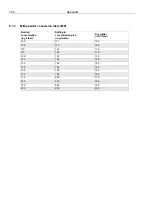
126
Appendix
9.3
User maintenance instructions
9.3.1
Care and Maintenance schedule / routine work
Regular maintenance work and functional checks on the automatic feeder and its accessories
ensure that the required hygiene standards are maintained. Maintenance includes calibration,
cleaning to maintain hygiene beyond the chapter on cleaning, as well as scheduled replace-
ment of wearing parts. Visual and functional testing of components as well as replacement of
simple wearing parts, such as the intake hose, can be carried out by the owner/operator.
Note:
Repair work and replacement of wearing parts on or in the automatic feeder, with the
exception of the intake hoses and teats, may
only
be carried out by a service engineer.
9.3.1.1 Important safety information
Danger of death by electric shock. The electrical components of the automatic
feeder are live. Turning off using the control switch does not disconnect the voltage to the unit.
Always turn off the automatic feeder first using the control switch before carrying out any work
on the automatic feeder or its components.
Risk of injury due to automatic start-up. The automatic feeder automatically pre-
pares a feeding portion when it detects a calf with feed entitlement. The automatically starting
stirring blades in the mixing tank can crush or cut off your hand or fingers. Always turn off the
automatic feeder with the control switch and disconnect the mains plug before carrying out any
work on the mixer. Only clean the powder discharge opening with the scraper supplied.
Risk of injury due to automatic start-up. Do not reach into the hazardous area of
the powder mixing unit. The powder mixing unit can start up automatically at any time, crushing
or cutting off your fingers. Turn off the automatic feeder with the control switch and disconnect
the mains plug before reaching into the powder container.
Chemical burns from cleaning agents used. The cleaning agent can cause chem-
ical burns to the eyes or hands. Always wear goggles and protective gloves when using clean-
ing agents. Follow the safety instructions listed in the safety data sheet for the cleaning agent
and use the safety equipment specified.
An interruption or failure in feeding operation means that your calves will not
receive any feed. This can lead to malnutrition. Malnutrition can cause impaired growth and
development, increased susceptibility to illness or even the death of your calves. You must
Summary of Contents for TAP5-CH2-25
Page 2: ......
Page 6: ...6 Table of contents ...
Page 102: ...102 Running the automatic feeder ...
Page 119: ...Appendix 119 9 Appendix 9 1 Feeding 9 1 1 Standard feeding plans 9 1 1 1 Group A ...
Page 120: ...120 Appendix 9 1 1 2 Group B 9 1 1 3 Group C ...
Page 121: ...Appendix 121 9 1 1 4 Group D ...
Page 122: ...122 Appendix 9 1 1 5 Template for individual feeding plan ...
Page 123: ...Appendix 123 9 1 2 Basic principle of interval feeding ...





















